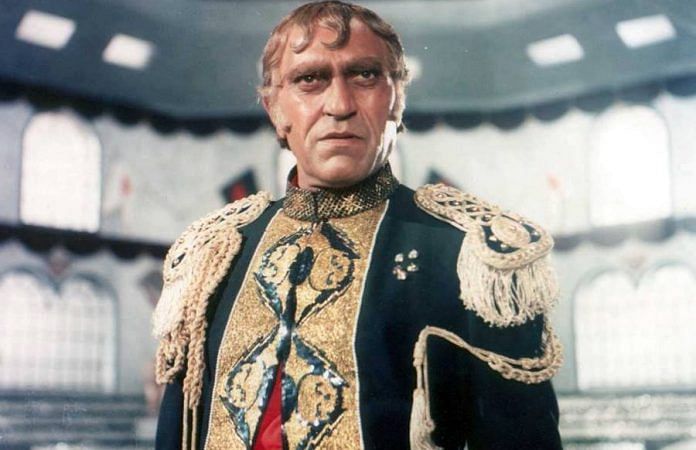On his 14th death anniversary, ThePrint takes a look at the career of Amrish Puri, whose exceptional range spanned both parallel and mainstream cinema.
Amrish Puri was India’s most loved villain on celluloid, with acknowledgment even from Hollywood, but the actor was bigger than just an archetype he’s usually remembered as.
Unlike many actors of his time, Puri ventured into the film industry only in his early forties but had a long, versatile career in both theatre and Bollywood.
Traversing the different terrains of parallel cinema and mainstream cinema in the ’70s through the ’90s, Puri did it all – the loud and the subtle, the great and the low-brow and the conventional.
On his 14th death anniversary, ThePrint takes a look at the life of the actor whose range spanned all genres and performance styles.
Early career
Puri was born on 22 June, 1932, in Jalandhar to a middle-class family. Two of Puri’s brothers — Chaman Puri and Madanlal Puri — were actors too, established much before he made his debut.
Madanlal, especially, was well-regarded with several memorable negative characters to his name.
Puri was also the first cousin of singer and actor Kundan Lal Saigal.
Hoping to make it in Bollywood, just like his brothers, Puri came to Bombay (now Mumbai) in the early 1950s. However, he failed a screen test for a film. This didn’t deter him from starting his career on the stage.
Puri worked for years in Mumbai’s theatre industry before getting a break in what later came to be known as Bollywood. During this period, with his legendary baritone, he also lent his voice for several advertising jingles and worked with the Labour Ministry.
Through his stint in theatre productions, Puri had the privilege of working with notable playwrights, including Satyadev Dubey.
Such was his stature in the world of theatre that he was awarded the Sahitya Natak Akademi Award in 1979, barely eight years after he made his debut in Hindi films.
Also read: Raj Kapoor, the ‘greatest showman’ of Indian cinema
Foray into films
Actor-director Sunil Dutt’s Reshma Aur Shera marked Puri’s debut in Hindi cinema. However, his role wasn’t considered significant enough to establish him. Puri did some regional films after this.
It was Shyam Benegal who took notice of Puri and cast him as a feudal landlord in Nishant, a 1975 film that featured an ensemble cast of actors like Girish Karnad, Shabana Azmi, and Smita Patil, all of whom went on to great careers themselves.
Puri garnered critical acclaim for his work in films that released subsequently. From being cast in supporting roles in the 1970s to playing the film’s villain or protagonist by the 1980s, he was appreciated for his roles in movies like Manthan (1976), Aakrosh (1980), Hum Paanch (1980), Kalyug (1981), Vidhaata (1982), Shakti (1982), Ardh Satya (1983), among others.
He worked with arthouse favourites like Benegal and Govind Nihalani to mainstream names like Ramesh Sippy.
The actor captivated international viewers too with his turns in Richard Attenborough’s Gandhi (1982) and Steven Spielberg’s Indiana Jones and the Temple of Doom (1984). The latter saw Puri play Mola Ram who made people cringe in fear with his terrifying role as a Kali-worshipping bald tantrik (priest). In Attenborough’s historical drama, Puri played the character of Mir Alam Khan, known to have assaulted Gandhi in South Africa.
And then came the film that defined Puri for the rest of his life. Shekhar Kapur’s memorable 1987 sci-fi flick Mr India — the last collaboration between writers Salim Khan and Javed Akhtar — gave Puri a new identity, ‘Mogambo’.
Any poll of Hindi cinema’s most iconic villain eventually boils down to two names — Gabbar Singh from Sholay (1975) and Mogambo from Mr India.
Puri’s catchphrase in Mr India, “Mogambo khush hua”, made a permanent place in Indian film history. Last year, at an American talk show, actor Riz Ahmed quoted it, bringing it back in spotlight.
Tom Hardy gives us his best #mogambo – what’s the verdict?
Think u can do better?
Post urs here with #mogambo before the single drops Oct 3rd… pic.twitter.com/TEkyvi9vdt
— Riz Ahmed (@rizwanahmed) September 30, 2018
Later career
Puri later progressed to playing the patriarch roles, the most iconic of which is Babuji from Aditya Chopra’s runaway blockbuster Dilwale Dulhaniya Le Jayenga (1995). He played an authoritarian but doting father to Kajol, with a famous climax sequence in a film that’s still running in a Mumbai theater. And he achieved this in the same year in which he played another memorable villain, Durjan Singh, in Rakesh Roshan’s Karan Arjun.
Bollywood’s top villain shined just as well in Chachi 420 with his comic turn in actor-director Kamal Hassan’s 1997 success.
In the last decade of his career, he saw successes in films like Virasat (1997), Mohabbatein (2000), Zubeidaa (2001), Gadar Ek Prem Katha (2001) and Dev (2004).
His last film was Subhash Ghai’s Kisna: The Warrior Poet (2005).
By the end of his career, he had acted in over 220 Hindi films, while his overall credits ran over 400. His legacy wasn’t just his baritone or the wide spectrum of characters he played, it was the gravitas that he brought to even minor characters, registering his presence in an industry that’s defined by heroes and stars.
He brought the “character actor” from the beneath the shadow of the hero, with a dignity that was his trademark.
Puri died on 12 January, 2005, after fighting a rare form of cancer.



